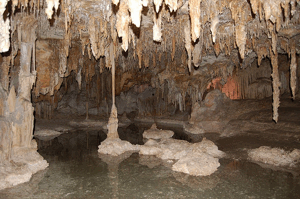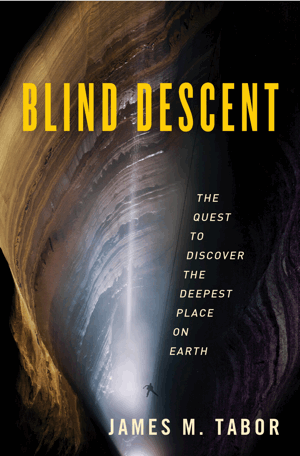Deepest Places
Air Date: Week of September 3, 2010

Caving and cave diving are among the most dangerous sports. (Photo: James Tabor)
The 2004 expeditions to find the deepest place on Earth, like many other significant terrestrial discoveries, were rife with competition, danger and intrigue. Author James Tabor wrote about these events in his book “Blind Descent: The Quest to Find the Deepest Place on Earth,” and talks with Living on Earth’s Steve Curwood.
Transcript
YOUNG: It’s Living on Earth. I’m Jeff Young. And now, the search for the deepest place on Earth. Finding it involves heading down, down into a super cave more than a mile deep, through miles of maze-like passages, some flooded. There are only about a half dozen of these super caves in the world, and they have proven so difficult to penetrate that explorers only recently discovered which one was actually the deepest. James Tabor has written the book about the rival teams searching for the ultimate cave – it’s called “Blind Descent: The Quest to Discover the Deepest Place on Earth,” he came into the studio for a deep discussion with Living on Earth’s Steve Curwood.
CURWOOD: Why write a book on caving?
TABOR: Because it was the greatest epic of science and adventure and exploration that no one ever heard about. We know immense amounts about Edmond Hillary, Armstrong, Aldrin, Shackelton, Perry, Scott, those people. This happened in 2004, and it went completely under the world’s radar screen. And I thought they deserved recognition, first of all, and also because the eighth continent, the underground world, is so fascinating. I’ve sampled enough of it to know that I thought readers would really be enthralled by this magical, underground world.
CURWOOD: Now, you describe caving in super-caves as climbing Mt. Everest in reverse!
TABOR: Yes.
CURWOOD: What do you mean by that?
TABOR: Well, the expeditions that descend into these super-caves involve scores of participants. They’re on site, not just for weeks, as in Everest, but for months. They cost hundreds of thousands of dollars, they require even more skill sets than Himalayan climbing does because you have to be very good at vertical work, rope work, rock climbing, but you also have to be a world class diver.

James Tabor’s new book about supercaving.
CURWOOD: Tell me about these deepest places on the planet, that the people you write about in your book were looking for. Where are they, and what remains to be discovered?
TABOR: Well, I’ll focus on Kruber, which did turn out to be the Mt. Everest of caves, the deepest one of all. It’s 7,200ft deep. So you could stack seven empire state buildings in the depth that it represents. Kruber is located in the Republic of Georgia, it’s about two miles of travel through various passages and sumps to get to that bottom.
CURWOOD: Explain a sump to people.
TABOR: A sump is a flooded tunnel. It’s a remarkably cold cave, the water temperature in Kruber is 32 degrees Fahrenheit always, because it’s fed by glacial melt. Air temperature in the summer is about 38 degrees Fahrenheit, but they prefer to climb in winter because there’s less chance of flooding, so then the air temperature is zero, which makes terminal hypothermia in Kruber a really serious possibility. I think the defining characteristics of many great super-caves are the vertical spaces. There’s a pit in Kruber called the grand cascade- 500 vertical feet…[MAKES FALLING NOISE]…just like that. And 90 percent of the terrain in Kruber, which looks in profile like a big elevator shaft, is actually vertical. You’re on rope 90 percent of the time, working your way down into Kruber.
CURWOOD: You know, in culture, the deepest cave is called Hell…
TABOR: (Laughs) That’s correct. And, I think a lot of people would call the kind of conditions that these folks have to encounter, very hellish. There is no rescue if you’re deep, deep, deep down in a super-cave. There’s no communication with the surface for one thing, and if you get hurt, it’s virtually impossible to bring an incapacitated person out through flooded sumps and up 500ft vertical drops.
CURWOOD: The only thing missing in these caves is a guy standing there with a pitchfork, and maybe a little heat, huh?
TABOR: You know, there may be somebody like that waiting down there for us yet, we just don’t know… (laughs)
CURWOOD: So, you’re saying that this is on a par with getting to the moon, getting to the top of Everest, finding the north pole, finding the south pole, all those things… this is a great exploration.
TABOR: I am saying that. This was the last great terrestrial discovery. We’ve been to the top of the mountains, the bottoms of the deepest oceans, the poles, everything. The bottom of the deepest cave on Earth was the last one. And, so, given the risks, and the significance, and the good science that’s gonna come out of it, yes, I would definitely put it on a par with those other things.
CURWOOD: So what was the most important discovery of Kruber? What did they find at the bottom of the deepest place on Earth?
TABOR: I think the most important thing was that they proved that humans can get to that place and that humans can function down there. I will cite just one example of scientific benefit that has come from other deep caves that have opened up. They brought out life-forms called extremophiles-- microbial life-forms. And, in the laboratories, they’re breeding new families of antibiotics from them, which are proving effective against our worst, most drug resistant bacteria.

Caving and cave diving are among the most dangerous sports. (Photo: James Tabor)
CURWOOD: So, what’s your favorite story from your book?
TABOR: It has to do with a relatively young caver named Emil Vash, who was one of the team that finally bottomed Kruber. At one point, deep in the cave, he came to something called the Death Sump, which required a breath-hold dive through a sump about ten feet long. So, it wasn’t very long but it was only 30 inches high, and it was only 18 inches wide, which is the width of your computer keyboard.
CURWOOD: Or a coffin, maybe…
TABOR: Or a coffin! Exactly. And, in fact, he got hung up and he almost did die. But, he extricated himself, came back out, went through a second time and made it. And, I think that grit, that persistence, that refusal to quit, just epitomized everything about super-caving for me.
CURWOOD: If you could read the passage that you have here….
TABOR: Vash had a premonition that he would not make it through, but he pushed on, regardless. He hyperventilated, briefly to blow carbon dioxide out of his system, held a last breath and dove.
His premonition quickly came true. He didn’t submerge deeply enough and halfway through, his helmet caught on a ceiling obstruction. Panicking, he flailed back out of the sump and surfaced, unnerved and gasping. It had been one of the worst moments, perhaps the worst moment, of his life.
Cavers are nothing if not persistent. Calming himself, Vash went in, once again, taking care to go all the way down to the tunnel’s floor, this time. He cleared the ceiling but found, terrifyingly, that the sump was so narrow that it pressed against the surface of his body and helmet. This was a very tight scrabble, while completely submerged, in zero visibility, 32-degree water.
When he finally popped out the other side, there was a weird similarity to birth about the whole thing. The painful passage through a constricted canal, followed by shocking emergence from water to air, in a cold room, where waited an oddly dressed man with lights on his head.
CURWOOD: You know, I’m going to sound biased to say this, but I think you gotta be nuts to do this. Can you imagine diving, I mean, going under water in a dark place, where you also have to be able to climb… I mean, just the thought of that and the claustrophobia starts to rattle in my body!
TABOR: Yeah, it’s not everyone’s cup of tea, by any means! You know, the darkness is absolute, there’s not a single lumen of light, the squeezes that you have to go through, the immense vertical drops, the freezing flooded tunnels and the increasing sense of isolation and aloneness. Really some deep part of the brain says, ‘oh boy, yeah this is kind of hellish.’ And, I think that, with people at that level there is this incredibly deep motivational urge to be first, to go where no one has gone before, and I think it may almost be irresistible.
CURWOOD: It’s the human thing…
TABOR: Exactly.
CURWOOD: To be first?
TABOR: Yes.
CURWOOD: James Tabor’s new book called “Blind Descent: The Quest to Discover the Deepest Place on Earth.” Thanks for taking this time with me, Jim!
TABOR: Thank you so much, I’ve been really glad to be here.
Links
Living on Earth wants to hear from you!
Living on Earth
62 Calef Highway, Suite 212
Lee, NH 03861
Telephone: 617-287-4121
E-mail: comments@loe.org
Newsletter [Click here]
Donate to Living on Earth!
Living on Earth is an independent media program and relies entirely on contributions from listeners and institutions supporting public service. Please donate now to preserve an independent environmental voice.
NewsletterLiving on Earth offers a weekly delivery of the show's rundown to your mailbox. Sign up for our newsletter today!
 Sailors For The Sea: Be the change you want to sea.
Sailors For The Sea: Be the change you want to sea.
 The Grantham Foundation for the Protection of the Environment: Committed to protecting and improving the health of the global environment.
The Grantham Foundation for the Protection of the Environment: Committed to protecting and improving the health of the global environment.
 Contribute to Living on Earth and receive, as our gift to you, an archival print of one of Mark Seth Lender's extraordinary wildlife photographs. Follow the link to see Mark's current collection of photographs.
Contribute to Living on Earth and receive, as our gift to you, an archival print of one of Mark Seth Lender's extraordinary wildlife photographs. Follow the link to see Mark's current collection of photographs.
 Buy a signed copy of Mark Seth Lender's book Smeagull the Seagull & support Living on Earth
Buy a signed copy of Mark Seth Lender's book Smeagull the Seagull & support Living on Earth

